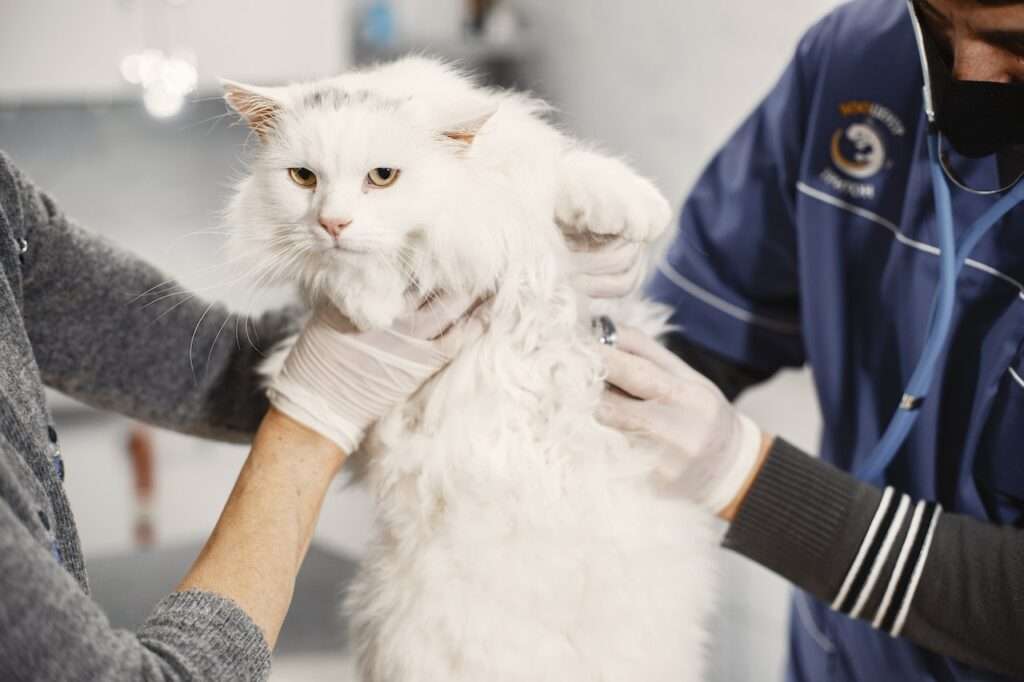Do Cats Bleed When in Heat? Warning Signs You Shouldn’t Ignore
Cats are fascinating creatures that bring joy and companionship into our lives. As cat owners, it’s important to understand our feline friends’ behavior and health, especially when it comes to their reproductive cycle.
One question that many cat owners have is whether do cats bleed when in heat? In this article, we’ll explore the ins and outs of the cat heat cycle, debunk some myths about bleeding, and provide insights into what to expect during this time.
Understanding the Cat Heat Cycle

The cat heat cycle, also known as estrus, is a fascinating and important aspect of a female cat’s reproductive cycle. To ensure the best care for your feline companion, it’s essential to have a good understanding of this natural process.
The heat cycle in cats typically begins when they reach sexual maturity, which is usually between 6 and 9 months of age. However, individual cats may start as early as 4 months or as late as 12 months. It’s crucial to note that early spaying or neutering can alter the timing and intensity of the heat cycle.
Stages of the Heat Cycle
The cat heat cycle consists of four stages: proestrus, estrus, interestrus, and anestrus. Let’s take a closer look at each stage:
- Proestrus: This initial stage lasts for approximately one to two days. During this time, the female cat may become more affectionate and display some behavioral changes. However, she is not yet receptive to mating.
- Estrus: The estrus stage is the main phase of the heat cycle, lasting about five to nine days on average. At this point, the female cat becomes sexually receptive and actively seeks a mate. She may exhibit increased vocalization, restlessness, and a strong desire for attention. Physical changes, such as a swollen vulva, are also common.
- Interestrus: The interestrus stage occurs if the cat does not mate during estrus. It typically lasts for one to two weeks. During this time, the female cat’s reproductive system prepares for another potential heat cycle.
- Anestrus: Anestrus refers to the resting period between heat cycles. It can last for several weeks to several months, depending on various factors such as season, breed, and individual cat differences. Cats may experience anestrus during the winter months or in response to environmental cues.
Caring for a Cat in Heat
When your cat is in heat, it’s important to provide extra care and attention. Here are some tips for ensuring her well-being:
- Keep her indoors: To prevent unwanted mating or accidental pregnancies, it’s best to keep your cat indoors during her heat cycle. This will also protect her from potential dangers and reduce the risk of encountering other animals.
- Provide comfort and stimulation: Increased attention and playtime can help alleviate restlessness during the heat cycle. Engage your cat with interactive toys and provide scratching posts to satisfy her natural instincts.
- Consider spaying: Spaying your cat is a responsible choice unless you have specific breeding plans and experience. Spaying not only prevents heat cycles but also offers numerous health benefits and helps control the stray cat population.
- Consult with a veterinarian: If you have any concerns or questions about your cat’s heat cycle or behavior, it’s always a good idea to consult with a veterinarian. They can provide personalized advice and ensure your cat’s overall well-being.
Remember, each cat is unique, and their heat cycles may vary. By understanding and respecting this natural process, you can provide the best care for your furry friend throughout her reproductive years.
Bleeding During Cat Heat Cycles
When it comes to cats in heat, there is a common misconception that they always experience bleeding. However, this is not entirely accurate. While some cats may exhibit bleeding during their heat cycle, others may not show any signs of bleeding at all.
If your cat does experience bleeding during her heat cycle, it’s typically a normal occurrence known as estrus bleeding. This bleeding is a result of the shedding of the uterine lining. The amount of bleeding can vary from cat to cat, with some experiencing minimal spotting, while others may have a slightly heavier flow.
Recognizing Abnormal Bleeding
While estrus bleeding is considered normal, it’s essential to differentiate it from abnormal bleeding. Abnormal bleeding during a cat’s heat cycle can be an indication of an underlying medical condition or complication. If you observe any of the following, it’s crucial to seek veterinary attention:
- Excessive or prolonged bleeding: If your cat is experiencing heavy bleeding that lasts for an extended period, it may be a cause for concern. Excessive bleeding can lead to anemia and may require medical intervention.
- Discharge with a foul odor: Unpleasant-smelling discharge, particularly if it is accompanied by bleeding, may signal an infection or other health issues. It’s important to have your cat examined by a veterinarian to determine the cause and provide appropriate treatment.
- Signs of discomfort or distress: If your cat appears to be in pain or discomfort during her heat cycle, or if she displays unusual behavior alongside bleeding, it’s essential to consult with a veterinarian. These symptoms could indicate an underlying health problem that needs attention.
If you are unsure whether your cat’s bleeding is normal or if you suspect something may be amiss, it’s always best to consult with a veterinarian. They can evaluate your cat’s overall health, perform any necessary tests, and provide guidance tailored to your feline companion’s specific needs.
Types of Bleeding During Cat Heat Cycles
When it comes to a cat’s heat cycle, it’s essential to distinguish between normal bleeding and abnormal bleeding. Knowing the difference can help you provide the appropriate care and seek veterinary attention when necessary.
- Normal Bleeding: Normal bleeding, also known as estrus bleeding, occurs during a cat’s heat cycle and is considered a natural part of the reproductive process. It is caused by the shedding of the uterine lining. Typically, this bleeding is light to moderate in nature and can last for a few days up to a week. It’s important to note that not all cats will experience normal bleeding during their heat cycle. Some cats may have minimal spotting, while others may not exhibit any bleeding at all.
- Abnormal Bleeding: Abnormal bleeding during a cat’s heat cycle is a cause for concern as it can indicate an underlying medical condition or complication. Unlike normal bleeding, abnormal bleeding may be heavier than usual and last longer than a week. Several factors can contribute to abnormal bleeding, including infection, injury, hormonal imbalances, or the presence of tumors.
As a caring pet parent, it’s important to monitor your cat’s heat cycle and be vigilant for any signs of abnormal bleeding. Keep a record of the duration, intensity, and frequency of bleeding, as this information will be helpful when discussing your concerns with a veterinarian.
Causes of Abnormal Bleeding During Cat Heat Cycles
Abnormal bleeding during a cat’s heat cycle can be unsettling for pet parents. Understanding the potential causes behind this issue can help you navigate your feline friend’s health with confidence. Here are some common causes of abnormal bleeding during a cat’s heat cycle:
- Infection: Infections are a frequent culprit behind abnormal bleeding. Bacterial, fungal, or viral infections can cause inflammation in the reproductive tract, leading to irregular bleeding. It’s essential to have your cat examined by a veterinarian to identify and treat any underlying infections promptly.
- Injury: Trauma to the reproductive tract can result in abnormal bleeding during heat cycles. Mating-related injuries or accidental trauma can disrupt the normal functioning of the reproductive organs. If you suspect your cat has experienced an injury, seeking veterinary care is crucial for appropriate diagnosis and treatment.
- Hormonal Imbalances: Hormonal imbalances can throw off the delicate balance of a cat’s reproductive cycle, leading to irregular bleeding. Conditions such as hypothyroidism or Cushing’s disease can disrupt hormone levels and contribute to abnormal bleeding. Your veterinarian can perform tests to assess hormone levels and guide you in managing any hormonal imbalances.
- Tumors: While less common, tumors in the reproductive tract can cause abnormal bleeding during a cat’s heat cycle. These tumors can be either benign or malignant. It’s essential to have your cat evaluated by a veterinarian if you suspect the presence of tumors. Prompt diagnosis and appropriate treatment can be crucial in managing these conditions.
Diagnosing Abnormal Bleeding During Cat Heat Cycles

When you observe abnormal bleeding during your cat’s heat cycle, it’s essential to prioritize your furry friend’s health by seeking prompt veterinary care. A veterinarian will perform a comprehensive physical examination to assess your cat’s overall condition and determine the underlying cause of the bleeding.
Diagnostic Tests for Accurate Diagnosis
To accurately diagnose the cause of abnormal bleeding, your veterinarian may recommend various diagnostic tests. These tests may include:
- Blood tests: Bloodwork can provide valuable insights into your cat’s overall health, hormonal balance, and identify any signs of infection or inflammation.
- Imaging studies: Imaging techniques like ultrasound or x-ray may be used to visualize the reproductive organs and detect any abnormalities or tumors that could be causing the bleeding.
- Biopsy: In some cases, a biopsy of the reproductive tract may be necessary to obtain tissue samples for further analysis. This can help identify the presence of tumors or other underlying issues.
Creating an Individualized Treatment Plan
Once the underlying cause of the abnormal bleeding is determined, your veterinarian will create an individualized treatment plan tailored to your cat’s specific needs. Treatment options may include:
- Medications: Depending on the diagnosis, medications such as antibiotics, hormone therapies, or anti-inflammatory drugs may be prescribed to address infections, hormonal imbalances, or reduce inflammation.
- Surgery: In cases where tumors or other structural abnormalities are identified, surgical intervention may be necessary to remove the affected tissue and alleviate the bleeding.
Prevention and Ongoing Care
Prevention is key to maintaining your cat’s reproductive health. Spaying your cat, preferably before her first heat cycle, can significantly reduce the risk of abnormal bleeding and eliminate the need to manage heat cycles altogether. Spaying also provides numerous health benefits, including the prevention of certain reproductive cancers.
Additionally, regular veterinary check-ups and maintaining a healthy lifestyle for your cat, including a balanced diet and appropriate exercise, can contribute to overall well-being and reduce the risk of complications.
Remember, by promptly seeking veterinary care, following recommended treatment plans, and taking preventive measures, you are prioritizing your cat’s health and ensuring a happier and healthier life for your feline companion.
Treatment for Abnormal Bleeding During Cat Heat Cycles
When it comes to addressing abnormal bleeding during a cat’s heat cycle, prompt veterinary care and a tailored treatment plan are essential for your furry companion’s well-being. Treatment options will depend on the underlying cause of the bleeding and may include medication or surgical intervention.
If an infection is identified as the cause of the abnormal bleeding, your veterinarian may prescribe antibiotics, antifungal medication, or antiviral drugs to combat the infection and restore your cat’s reproductive health. Hormonal imbalances can also be managed with medication designed to regulate hormone levels and restore balance to the reproductive cycle.
In cases where tumors are causing the abnormal bleeding, surgical removal of the tumor may be necessary. This surgical intervention aims to eliminate the source of bleeding and address any potential complications associated with the tumor. In certain situations, your veterinarian may recommend a complete or partial hysterectomy, a surgical procedure that removes the uterus, to prevent future bleeding and reduce the risk of reproductive-related health issues.
Throughout the treatment process, it’s crucial to closely follow your veterinarian’s instructions and administer any prescribed medication as directed. Monitor your cat’s condition for any changes and report them to your veterinarian promptly. Regular check-ups and follow-up appointments will allow your veterinarian to assess the progress of treatment and make any necessary adjustments to ensure the best outcome for your cat.
With the right treatment and care, many cats experiencing abnormal bleeding during their heat cycle can go on to lead happy and healthy lives. By working closely with your veterinarian and providing a nurturing environment, you are actively contributing to your cat’s well-being and ensuring a brighter future for your beloved feline companion.
Prevention of Abnormal Bleeding During Cat Heat Cycles
When it comes to preventing abnormal bleeding during your cat’s heat cycle, spaying is the most effective and responsible solution. Spaying, which involves the removal of the uterus and ovaries, eliminates the hormonal changes associated with heat cycles, reducing the chances of abnormal bleeding and offering several other important benefits.
By opting for spaying, you can safeguard your cat’s long-term health. This procedure significantly lowers the risk of specific reproductive cancers that can develop later in life. Spaying also eliminates the potential complications that may arise during heat cycles, such as infections or hormonal imbalances. It provides peace of mind, knowing that you’re proactively taking steps to prevent potential health issues.
Another significant advantage of spaying is preventing unplanned pregnancies. By eliminating the ability to reproduce, you’re helping to control the population of cats and reducing the strain on shelters and rescue organizations. Unwanted litters can lead to overpopulation, putting additional stress on limited resources and potentially resulting in animals not receiving the care and attention they deserve.
Choosing to spay your cat is a responsible decision that positively impacts her life and the welfare of other animals. By preventing abnormal bleeding during heat cycles and minimizing the risk of reproductive-related health problems, you’re prioritizing your feline companion’s well-being.
When considering spaying, consult with a veterinarian who can guide you through the process. They will provide recommendations tailored to your cat’s specific needs and age. Spaying is typically performed when a cat is young, ideally before her first heat cycle, to maximize its health benefits.
Conclusion
In conclusion, bleeding during a cat’s heat cycle is a normal and expected occurrence. However, it’s important to understand the types of bleeding that can occur and to seek veterinary care if abnormal bleeding is observed.
Abnormal bleeding during a cat’s heat cycle can be caused by a variety of factors, including infection, injury, hormonal imbalances, and tumors. Early diagnosis and treatment can help prevent more serious health problems from developing.
The best way to prevent abnormal bleeding during a cat’s heat cycle is to have your cat spayed. Spaying not only eliminates the risk of heat cycles and associated health problems, but also has additional benefits such as reducing the risk of certain types of cancers and preventing unwanted litters.
As responsible pet owners, it’s our duty to ensure the health and well-being of our feline friends. By understanding the signs and symptoms of abnormal bleeding during a cat’s heat cycle, seeking prompt veterinary care, and taking preventive measures such as spaying, we can help ensure that our cats stay healthy and happy throughout their lives.
Frequently Asked Questions
Q: Do cats bleed when in heat?
A: No, female cats do not typically experience bleeding when they are in heat. Unlike some other animals, such as dogs, cats do not have a menstrual cycle characterized by bleeding. Instead, they have an estrus cycle, during which they may display other behaviors and physical signs.
Q: What are the signs that a female cat is in heat?
A: Female cats in heat may exhibit several signs, including increased vocalization, restlessness, rolling on the floor, rubbing against objects or people, heightened affection, and a tendency to assume a mating position with raised hindquarters and a swaying tail.
Q: How long does a cat’s heat cycle last?
A: The duration of a cat’s heat cycle can vary but typically lasts around 4 to 10 days. However, this can be influenced by various factors, such as breed, age, and individual cat differences. It’s important to note that cats can go into heat multiple times throughout the year, especially if they are not spayed or become pregnant.
Q: Can a cat become pregnant during her first heat cycle?
A: Yes, a cat can become pregnant during her first heat cycle, although it is generally recommended to wait until a cat has reached sexual maturity (around 6 to 9 months old) before allowing her to breed. Early breeding can have health risks for young, immature cats.
Q: How often do cats go into heat?
A: Cats are polyestrous animals, which means they can go into heat multiple times throughout the year. The frequency of heat cycles can be influenced by factors such as breed, season, and whether the cat is indoor or outdoor. On average, cats experience heat cycles every 2 to 3 weeks during the breeding season, which typically occurs from spring to fall.
Q: Should I spay my female cat to prevent heat cycles?
A: Spaying, or ovariohysterectomy, is a common procedure that involves removing a female cat’s reproductive organs. It not only prevents heat cycles but also offers various health benefits and helps control the population of stray and unwanted cats. Spaying your cat is generally recommended unless you have specific breeding plans and experience.
Q: Can a spayed cat go into heat?
A: No, a spayed cat should not go into heat. Spaying involves removing the ovaries and uterus, which eliminates the hormonal changes that trigger heat cycles in intact (non-spayed) female cats. If you notice any signs of heat in a spayed cat, it is advisable to consult with a veterinarian to rule out any remaining ovarian tissue or other medical conditions.
Remember, if you have any concerns about your cat’s health or behavior, it’s always best to consult with a veterinarian for accurate and personalized advice.
References
- VCA Hospitals. “Estrus Cycles in Cats.” VCA Animal Hospitals. Retrieved from: https://vcahospitals.com/know-your-pet/estrus-cycles-in-cats
- PetMD. “Cat Facts: How Long Are Cats in Heat?” PetMD. Retrieved from: https://www.petmd.com/cat/care/evr_ct_cat-facts-how-long-are-cats-in-heat
- Purina UK. “Understanding Your Cat’s Heat Cycle.” Purina. Retrieved from: https://www.purina.co.uk/articles/cats/health/pregnancy/cat-heat-cycle
- ASPCA. “Spay/Neuter Your Pet.” American Society for the Prevention of Cruelty to Animals (ASPCA). Retrieved from: https://www.aspca.org/pet-care/general-pet-care/spayneuter-your-pet





